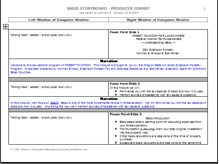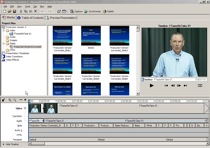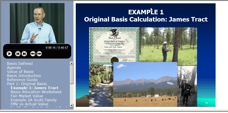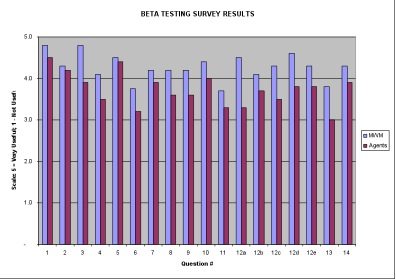 |
June 2009
|
June 2009 // Volume 47 // Number 3 // Ideas at Work // v47-3iw5
Distance Education: Taking the First Steps
Abstract
The project described here allowed the author to investigate the creative skills and technological knowledge required to produce an effective and engaging distance education program. The module simulates a "traditional" classroom setting by synchronizing a videotaped lecture with accompanying PowerPoint slides. The product was evaluated with a test audience, which indicated a strong and positive acceptance of this format for Extension programming.
Introduction
Distance education is currently the fastest growing form of domestic and international education (McIssac & Gunawardena, 2001). Today 20% of all U.S. citizens, or nearly 40 million adults, turn to the Internet for most of their science news (Horrigan, 2006), and the trend towards electronic delivery of information is going to increase for all audiences (Richardson, Clement, & Mustian, 1997). The primary audience that must adopt or reject distance education initially is county Extension educators, and Extension can either accept and adopt distance education or risk becoming obsolete (Dromgoole & Boleman, 2006; Williamson & Smoak, 2005).
While there are exciting opportunities in the distance learning arena, it is nevertheless somewhat daunting because many of us in Extension have not yet developed the capacities requisite to capitalize on those opportunities.
Purpose
The main purpose for the project I describe here was to learn the skills needed to design and create educational programs specifically for a distance education format, which we had no prior experience with and recognized require special preparation (Dillon & Walsh, 1992). We also wanted to develop a production process that required a minimum of time, technical expertise, and cost, but still resulted in an effective, engaging, and flexible format that could be adopted for a wide range of future modules.
The program we elected to create is titled Forestland Taxes—Understanding Basis, a topic applicable to woodland owners nationwide. The project was funded through a $12,000 grant from the USDA Forest Service Cooperative Forestry Programs.
The first concern was how to design our story for a multimedia format, so we utilized storyboarding, which methodically helps us to analyze the story frame-by-frame and to think how best to convey the message through a blend of text, graphics, photographs, and video. Using a storyboard has a number of advantages (Mallon, 1995; Stevens, 2007):
- Organizes and focuses the story
- Insures the information in each medium is complementary not redundant
- Creates a detailed plan what the end product should look and sound like
- Establishes a common point of reference so participants understand the objectives
- Identifies needed transitions between story elements
- Points out mistakes, reducing revisions and costs
- Speeds up production time
- Inspires new ideas
- Provides a tool to sell the project idea to prospective teammates or financial backers
- Establishes a template for content writer to work with.
Storyboarding was undoubtedly the single most valuable new tool we employed in creating this distance education module (Figure 1).
Figure 1.
Forestland Taxes Storyboard
Next, a PowerPoint program and accompanying script were created. In a face-to-face class, the lecturer can amplify and clarify the presentation in response to audience interactions. However, in our format, direct interactions are not possible, so a clear and thorough message was essential, which required a well-worded script.
The module includes an on-screen window displaying a videotape of the lecturer, providing a sense of connection to a real person. Good quality video and sound are requisite for a professional appearance, and authors with average skills can capture acceptable video if they use a room with good acoustics and appearance. A clip-on microphone improves the sound substantially. Good audio makes photos and video seem more intense and real, but bad sound does the reverse.
The program was created with Microsoft Producer software, which is free and easy to learn but unfortunately only runs well with Windows operating systems and the Internet Explorer Web browser.
Figure 2 shows an example of a MS Producer working window.
Figure 2.
MS Producer Working Window
The video and PowerPoint slides are placed on the timeline (shown at the bottom) and then synchronized.
Figure 3 shows what the completed program looks like. When a student clicks on an item in the Table of Contents below the "talking head," the program immediately jumps to that section, allowing the student to review specific topics as needed.
Figure 3.
Program in Progress
Results and Discussion
The program was tested with 12 Master Woodland Managers (MWMs) and 12 Forestry Extension personnel. We created an 18-point questionnaire to evaluate the look, feel, and effectiveness of the program. The respondents rated each question on a scale of 1 (poor) to 5 (good). They also were encouraged to write a detailed response to each question. A graph depicting their average responses is shown in Figure 4.
Figure 4.
MWM and Forestry Extension Staff
Questionnaire Responses
The MWMs consistently rated the program very positively. The Extension staff response was also positive, although somewhat less so. Many respondents affirmed they would like Extension to offer more programs through this particular format.
The written comments also provided useful insights.
- "This is a perfect format for the information as it is well-organized and clear, and it is easy to review a section, as needed."
- "I would attend a live educational program but with time constraints would use this type more frequently."
- "The only better way in my estimation would be a live lecture. A CD lets you repeat which is actually better than a lecture."
A number of changes were made to the program as a result of the questionnaire. We shortened it from 65 minutes to 45, a few slides were enhanced to make them more readable on-screen, and some topics were addressed in greater detail.
Sophisticated technical skills are not requisite to create a distance education module and should not be an overriding concern. This author possessed only rudimentary PowerPoint skills and was initially intimidated by the new software. But once I jumped in and started working with Producer, I found it very easy to use. Realistically, if you can create a PowerPoint program, you can create a distance education module similar in complexity to Forestland Taxes. The length of time required for a novice to create his or her first module will vary widely depending on the skills, aptitude, and motivation of the individual and, probably more important, the complexity of the project, which is a good argument for keeping the first project short and simple.
We found that focused, hands-on training can substantially shorten the learning curve and improve product quality. Our effort benefited from approximately 2 days of training from Bob Rost and Steve Dodrill at OSU's Department of Extension and Experiment Station Communications (EESC) on: storyboarding, capturing video and audio, video editing, and using the MS Producer software. We were also assisted by Jeff Hino at the OSU College of Forestry's Media Center, who videotaped the lecture in a professional-quality recording facility, improving the appearance and sound quality of the lecture video.
The EESC training and our hands-on practical experience have provided sufficient knowledge and skill that creating future distance education modules will require an effort similar to that of creating "traditionally" formatted modules. And we can now mentor others and help them avoid mistakes and pitfalls that lengthened our time unnecessarily.
Previous work with woodland owners indicated forestland taxes was a high-priority topic and suitable for this project. But in general, we don't yet understand well the needs and interests of people most likely to use distance education, so well-designed surveys would help us strategize where best to put our energies to reach these new audiences (Bardon, Hazel, & Miller 2007).
Conclusions
Our module has been well received, and our clients indicate they would like to see Extension offer more products on this format. The project demonstrated that learning the creative and technical skills required for creating distance education materials in this format is not difficult, and, once the basic skills are developed, outside expertise and financial requirements are minimal while the opportunities to reach new audiences and maintain relevance in the education marketplace are significantly expanded. This benefit seems to justify the relatively minimal investment of time and effort.
References
Bardon, R., Hazel, D., & Miller, K. (2007). Preferred information delivery methods of North Carolina forest landowners. Journal of Extension [On-line], 45(5) Article 5FEA3. Available at: http://www.joe.org/joe/2007october/a3.php
Dillon, C., & Walsh, S. (1992). Faculty: The neglected resource in distance education. American Journal of Distance Education, 6(3), 5-21.
Dromgoole, D., & Boleman, C. (2006). Distance education: Perceived barriers and opportunities related to Extension program delivery. Journal of Extension [On-line], 44(5) Article 5RIB1. Available at: http://www.joe.org/joe/2006october/rb1.php
Horrigan, J. (2006). The Internet as a resource for news and information about science: The convenience of getting scientific material on the web opens doors to better attitudes and understanding of science. PEW Internet & American Life Project. Retrieved December 17, 2007 from: http://www.pewinternet.org/
Mallon, A. (1995). Storyboarding multimedia. Compuserve: Our World. Retrieved December 17, 2007 from: http://ourworld.compuserve.com/homepages/adrian_mallon_multimedia/story.htm
McIsaac, M. S., & Gunawardena, C.N. (1996). Distance education. In D.H. Jonassen (Ed), Handbook of research for educational communications and technology: a project of the Association for Educational Communications and Technology. 403-437. New York: Simon & Schuster Macmillan. Retrieved December 17, 2007 from: http://seamonkey.ed.asu.edu/~mcisaac/dechapter/
Richardson, J., Clement, D., & Mustian, R. (1997). Reaching traditional and nontraditional Extension audiences. Journal of Applied Communications, 81(3).
Stevens, J. (2007). A story from start to finish. Knight Digital Media Center. UC Berkeley Graduate School of Journalism and USC Annenberg School for Communication. Retrieved December 17, 2007 from: http://multimedia.journalism.berkeley.edu/tutorials/reporting/starttofinish/storyboarding
Williamson, R., & Smoak, E. (2005). Embracing edutainment with interactive E-Learning tools. Journal of Extension [On-line], 43(5) Article 5IAW2. Available at: http://www.joe.org/joe/2005october/iw2.php




